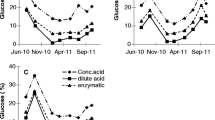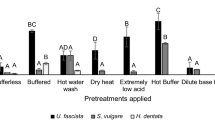Abstract
The red seaweeds are generally known to have a high content of polysaccharides and low content of lignin. They can be used as a bioethanol feedstock and to produce biochemicals. This study was conducted to examine the pretreatment conditions to improve the production of fermentable sugars and by-products from Gracilaria fisheri and Gracilaria. tenuistipitata. The algal materials were gathered from earthen pond cultivation. The pretreatment was conducted at different concentrations of H2SO4 (0.2–1 M) and time (30–150 min) at 95 °C. The proximate composition and contents of glucose, galactose, levulinic acid, and 5-hydroxymethylfurfural (5-HMF) were analyzed. Our results showed high carbohydrate content of 63.01 ± 0.47 g carbohydrate (100 g TS)−1 for G. fisheri and 59.07 ± 0.43 g carbohydrate (100 g TS)−1 for G. tenuistipitata. The optimal pretreatment with 1 M of H2SO4 at 95 °C for 150 min resulted in high concentrations of sugars in G. fisheri (7.86 g L−1 glucose, 8.37 g L−1 galactose) compared to G. tenuistipitata (3.15 g L−1 glucose, 5.75 g L−1 galactose). The pretreatment of the algae resulted in concentrations of 5-HMF for G. fisheri and G. tenuistipitata of 1.55 and 1.42 g L−1, respectively. The levulinic acid concentration was 3.66 g L−1 for G. fisheri and 6.12 g L−1 for G. tenuistipitata. Gracilaria fisheri was more susceptible to the sulfuric acid hydrolysis compared to G. tenuistipitata. Our study revealed that the acid hydrolysis of G. fisheri and G. tenuistipitata can improve the yield of sugars to produce bioethanol feedstocks.



Similar content being viewed by others
References
Anonymous (2017a) Energy situation in Thailand: January-December 2017. Department of Alternative Energy Development and Efficiency, Ministry of Energy, Bangkok, 5 pp (in Thai)
Anonymous (2017b) Report of ethanol situation price in Thailand: quarter 4/2017. Bank of Thailand, Bangkok, 8 pp (in Thai)
AOAC International (2005) Official methods of analysis of AOAC International, 18th edn. AOAC International, Gaithersburg
Benjama O, Masniyom P (2012) Biochemical composition and physicochemical properties of two red seaweeds (Gracilaria fisheri and G. tenuistipitata) from the Pattani Bay in southern Thailand. Songklanakarin. J Sci Technol 34:223–230
Chen Y-W, Lee H-V, Juan J-C, Phang S-M (2016) Production of new cellulose nanomaterial from red algae marine biomass Gelidium elegans. Carbohydr Polym 151:1210–1219
Chirapart A, Munkit J, Lewmanomont K (2006) Changes in yield and quality of agar from the agarophytes, Gracilaria fisheri and G. tenuistipitata var. liui cultivated in earthen ponds. Kasetsart J (Nat Sci) 40:529–540
Chirapart A, Praiboon J, Puangsombat P, Pattanapon C, Nunraksa N (2014) Chemical composition and ethanol production potential of Thai seaweed species. J Appl Phycol 26:979–986
Cho H, Ra C-H, Kim S-K (2014) Ethanol production from the seaweed Gelidium amansii, using specific sugar acclimated yeasts. J Microbiol Biotechnol 24:264–269
Chynoweth DP (2002) Review of biomethane from marine biomass. A report prepared for Tokyo Gas Company. In: Ltd
Ciepiela GA, Godlewska A, Jankowska J (2016) The effect of seaweed Ecklonia maxima extract and mineral nitrogen on fodder grass chemical composition. Environ Sci Pollut Res 23:2301–2307
Craigie JS, Wen ZC, van der Meer JP (1984) Interspecific, intraspecific and nutritionally determined variations in the composition of agars from Gracilaria spp. Bot Mar 27:55–61
Feng D, Liu H, Li F, Jiang P, Qin S (2011) Optimization of dilute acid hydrolysis of Enteromorpha. Chin J Oceanol Limnol 29:1243–1248
Goering HK, Van Soest PJ (1970) Forage fiber analysis (apparatus, reagent, procedures and some applications). Agric. Handbook, No. 379, ARS-USDA, Washington, DC
Graciela SD, Elisabete B, João ON, Sidney P, Sergio OL (2011) Gross chemical profile and calculation of nitrogen-to-protein conversion factors for five tropical seaweed. Am J Plant Sci 2:287–296
Herrera A, Téllez-Luis SJ, González-Cabriales JJ, Ramı́rez M, Vázquez JA (2004) Effect of the hydrochloric acid concentration on the hydrolysis of sorghum straw at atmospheric pressure. J Food Eng 63:103–109
Ho S-H, Huang S-W, Chen C-Y, Hasunuma T, Kondo A, Chang J-S (2013) Bioethanol production using carbohydrate-rich microalgae biomass as feedstock. Bioresour Technol 135:191–198
Hong I-K, Jeon H, Lee S-B (2014) Comparison of red, brown and green seaweeds on enzymatic saccharification process. J Ind Eng Chem 20:2687–2691
Jeong GT, Park DH (2010) Production of sugar and levulinic acid from marine biomass Gelidium amansii. Appl Biochem Biotechnol 161:41–52
Jiang R, Ingle KN, Golberg A (2016) Macroalgae (seaweed) for liquid transportation biofuel production: what is next? Algal Res 14:48–57
Kim JK, Yarish C (2014) Development of a sustainable land-based Gracilaria cultivation system. Algae 29:217–225
Kim JK, Yarish C, Hwang EK, Park M, Kim Y (2017) Seaweed aquaculture: cultivation technologies, challenges and its ecosystem services. Algae 32:1–13
Kim SW, Hong C-H, Jeon S-W, Shin H-J (2015) High-yield production of biosugars from Gracilaria verrucosa by acid and enzymatic hydrolysis processes. Bioresour Technol 196:634–641
Lahaye M, Rochas C, Yaphe W (1986) A new procedure for determining the heterogeneity of agar polymers in the cell wall of Gracilaria spp. (Gracilariaceae, Rhodophyta). Can J Bot 64:579–585
McDermid KJ, Stuercke B (2003) Nutritional composition of edible Hawaiian seaweeds. J Appl Phycol 15:513–524
McDermid KJ, Stuercke B, Balazs GH (2007) Nutritional composition of marine plants in the diet of the green sea turtle (Chelonia mydas) in the Hawaiian Islands. Bull Mar Sci 81:55–71
Meinita NDM, Jeong GT, Hong YK (2012) Comparison of sulfuric and hydrochloric acids as catalysts in hydrolysis of Kappaphycus alvarezii (cottonii). Bioprocess Biosyst Eng 35:123–128
Meinita MDN, Marhaeni B, Winanto T, Setyaningsih D, Hong Y-K (2015) Catalytic efficiency of sulfuric and hydrochloric acids for the hydrolysis of Gelidium latifolium (Gelidiales, Rhodophyta) in bioethanol production. J Ind Eng Chem 27:108–114
Munier M, Dumay J, Morançais M, Jaouen P, Fleurence J (2013) Variation in the biochemical composition of the edible seaweed Grateloupia turuturu Yamada harvested from two sampling sites on the Brittany Coast (France): the influence of storage method on the extraction of the seaweed pigment R-phycoerythrin. J Chem 2013:1–8
Narasimman S, Murugaiyan K (2012) Proximate composition of certain selected marine macro-algae form Mandapam coastal region (Gulf of Mannar), southeast coast of Tamil Nadu. Int J Pharm Biol Arch 3:918–921
Norziah MH, Ching CY (2000) Nutritional composition of edible seaweed Gracilaria changii. Food Chem 68:69–76
Nunraksa N, Praiboon J, Puangsombat P, Chirapart A (2015) Effects of hydrochloric acid pretreatment on ethanol yield of the agarophyte, Gracilaria tenuistipitata. KU Fish Res Bull 39(1):38–47
Pimentel D, Marklein A, Toth MA, Karpoff M, Paul GS, McCormack R, Kyriazis J, Krueger T (2008) Biofuel impacts on world food supply: use of fossil fuel, land and water resources. Energies 1:41–78
Praiboon J, Chirapart A, Akakabe A, Bhumibhamond O, Kajiwara T (2006) Physical and chemical characterization of agar polysaccharides extracted from the Thai and Japanese species of Gracilaria. Sci Asia 32(suppl 1):11–17
Ra CH, Choi JG, Kang C-H, Sunwoo IY, Jeong G-T, Kim S-K (2015) Thermal acid hydrolysis pretreatment, enzymatic saccharification and ethanol fermentation from red seaweed, Gracilaria verrucosa. Microbiol Biotechnol Lett 43:9–15
Raspolli Galletti, AM, Antonetti C, De Luise V, Licursi D, di Nasso NN (2012) Levulinic acid production from waste biomass. BioResources 7:1824–1835
Robic A, Sassi J-F, Dion P, Lerat Y, Lahaye M (2009) Seasonal variability of physico-chemical and rheological properties of ulvan from two Ulva species (Chlorophyta) of Brittany coast. J Phycol 45:962–973
Ruangchuay R, Lueangthuvapranit C, Nuchaikaew M (2010) Cultivation of Gracilaria fisheri (Xia & Abbott) Abbott, Zhang & Xia (Gracilariales, Rhodophyta) in abandoned shrimp ponds along the coast of Pattani Bay, southern Thailand. Algal Resour 3:185–192
Taherzadeh MJ, Karimi K (2007) Acid-based hydrolysis processes for ethanol from lignocellulosic materials: a review. Bio Resour 2:472–499
Usov AI (2011) Polysaccharides of the red algae. Adv Carbohydr Chem Biochem 65:115–217
Wackett PL (2011) Engineering microbes to produce biofuels. Curr Opin Biotechnol 22:388–393
Wi SG, Kim HJ, Mahadevan SA, Yang D-J, Bae H-J (2009) The potential value of the seaweed Ceylon moss (Gelidium amansii) as an alternative bioenergy resource. Bioresour Technol 100:6658–6660
Yarnpakdee S, Benjakul S, Kingwascharapong P (2015) Physico-chemical and gel properties of agar from Gracilaria tenuistipitata from the lake of Songkhla, Thailand. Food Hydrocoll 51:217–226
Acknowledgements
This research was partly supported by the Graduate Scholarship “72 years Scholarship Kasetsart University.” The authors wish to thank Prof. Dr. Rapeeporn Ruangchuay and the Surat Thani Coastal Fisheries Research and Development Center for kindly supporting the Gracilaria samples. Special thanks to anonymous reviewers whose remarks helped to improve this paper.
Author information
Authors and Affiliations
Corresponding author
Rights and permissions
About this article
Cite this article
Nunraksa, N., Rattanasansri, S., Praiboon, J. et al. Proximate composition and the production of fermentable sugars, levulinic acid, and HMF from Gracilaria fisheri and Gracilaria tenuistipitata cultivated in earthen ponds. J Appl Phycol 31, 683–690 (2019). https://doi.org/10.1007/s10811-018-1552-9
Received:
Revised:
Accepted:
Published:
Issue Date:
DOI: https://doi.org/10.1007/s10811-018-1552-9




